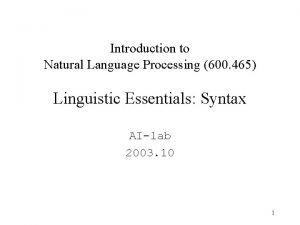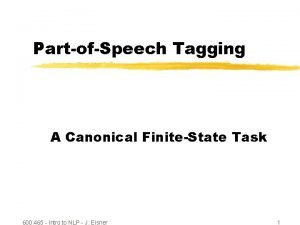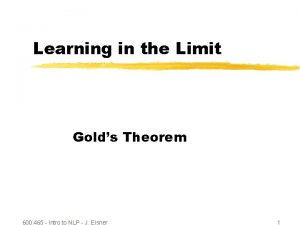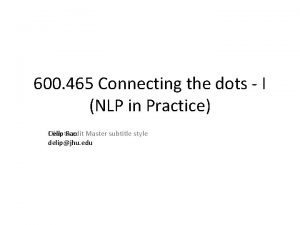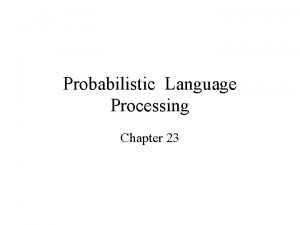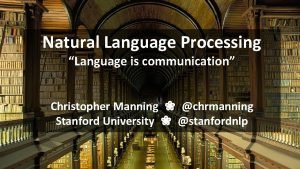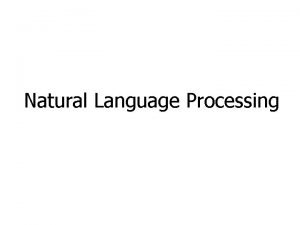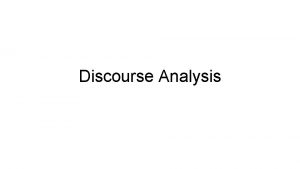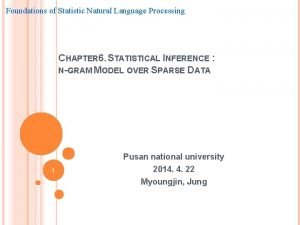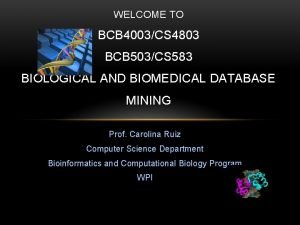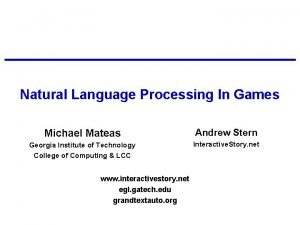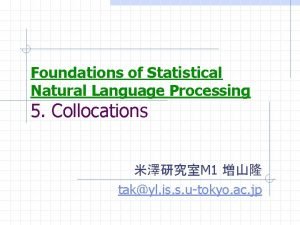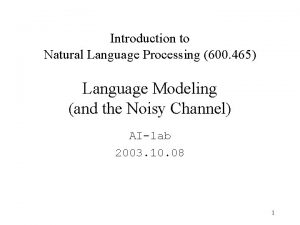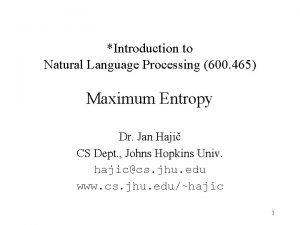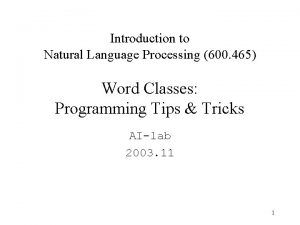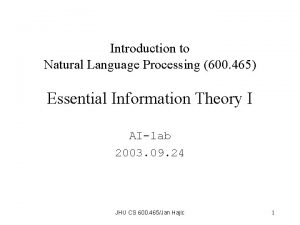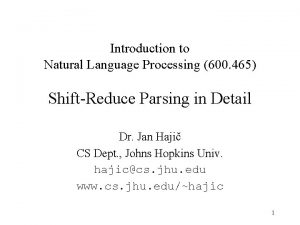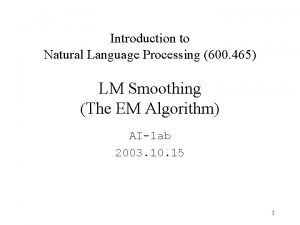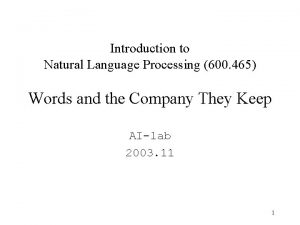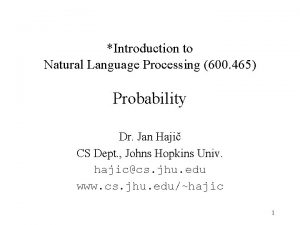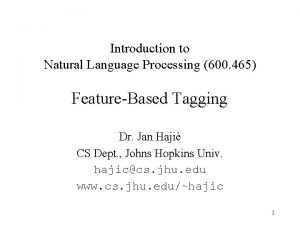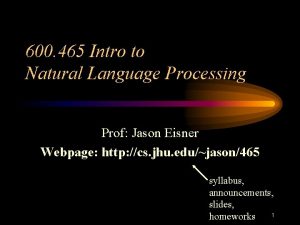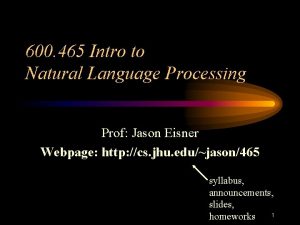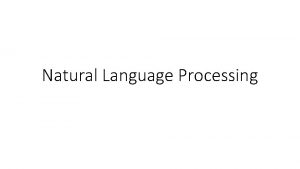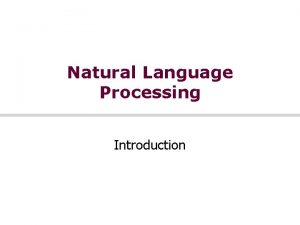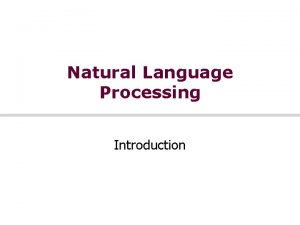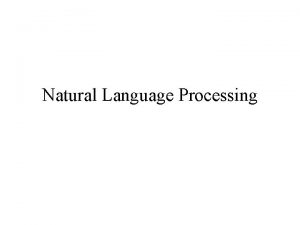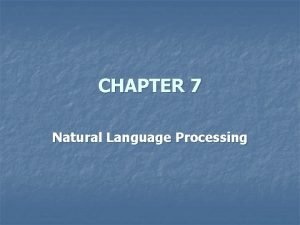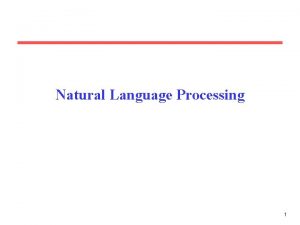Introduction to Natural Language Processing 600 465 Linguistic


















- Slides: 18

Introduction to Natural Language Processing (600. 465) Linguistic Essentials: Syntax AI-lab 2003. 10 1

The Place of Syntax • Between Morphology and Meaning • Morphology provides/expects: – lemmas (now it’s time to extract syntactic information from a dictionary) – tags (Part-of-Speech and combination of morphological categories, such as number, case, tense, voice, . . . ) – and of course, we also have word order now to look at/provide • Typically multiple input (non-disambiguated morphology) / output (multiple syntactic structures, non-disambiguated) 2

Words, Phrases, Clauses, Sentences • Words – smallest units on the syntax level • function/autosemantic • Phrases – consist of words and/or phrases; “constituents” • Clauses – have predicative meaning (single predicate) • Sentences – consist of clauses (one or more) 3

Words • Words – lexical units • auxiliary (function) words: have grammatical function • autosemantic words (“lexical” words) – idioms • fixed phrases (non-compositional) -> “words” • Relate to other words – dictionary: repository of information for each words about its (idiosyncratic) relations to other words 4

Phrases • Phrases – sequences of words and/or phrases (i. e. of constituents) • may be discontinuous, sometimes • Types of Phrases: – Simple/Clausal (i. e. clauses, which consist of phrases, behave like phrases. . . recursively!) – According to head type: • • • Noun: a new book Adjective: brand new Adverbial: so much Prepositional: in a class Verb: catch a ball 5

Noun Phrases • Head: noun – – – water a book new ideas that small village The greatest rise of interest rates since W. W. II within a single year – an operating system which, despite great efforts on the part of our administrators, fails all too often 6

Adjective Phrases • Head: adjective • Simple APs very common, complex APs rare – – – old very old really very old five times older than the oldest elephant in our ZOO (was) sure, as far as I know, to be there first 7

Adverbial and Numerical Phrases • Head: adverb – – – three times as much quickly really (. . . speaks) more loudly than anybody could imagine yesterday • Numerical Phrases – (. . . lasted) three hours – twenty-two 8

Prepositional Phrases • Head: preposition • In fact, play the role of Adverbial Phrases often – – – – in the City at five o’clock to a brightest future without a glitch to the point where neither of them could get out of it up to five points instead of Charles 9

Verb Phrases • Head: verb – – – – (It) rains. . . could ever see a large Unidentified Flying Object. . . , why (we) have got so much rain Please! On Sunday, (he) was driven to the hospital (It) began to snow (. . . ) prohibits smoking in this area 10

Coordination of Phrases • “Head”: conjunction, punctuation – and, or, but • • cats and dogs new or even newer quickly and precisely he came to the conclusion that it makes no sense to hide himself anymore and therefore we could hear him today • (trains) from and to Baltimore • eat your lunch now or at the picnic table 11

Ellipsis • Word or Phrase missing where one would normally expect one; often happens in dialogues – Whom did you see there? – Peter. ? ? verb ? ? • Most common in coordination (written text) – Pittsburgh leads 4 -0 but Detroit only 3 -1. ? ? verb in 2 nd part? ? • Systematic in many languages: pro-drop (leave out a pers. pronoun in the Subject position) – [She] Passed the exam easily. 12

Clauses • Predicative function: – some activity of some subjects/objects, somewhere in time, under certain circumstances • Main clause – not part of a greater clause • Embedded clause – part of other clause, having some function (like a phrase) • Function of a Clause – same as for phrase, plus some (direct speech etc. ) 13

Gaps (Non-Continuous Constituents) • Constituent moves from the expected position: – happens in questions and relative clauses • Who(m) do you work for <gap>whom? – strictly speaking, do you work should be you (do work) • I don’t know why we have got so much rain <gap>why? • On Sundays, I usually work <gap>On Sundays but I stay home on Tuesdays. • The story he never wrote <gap>the story • And finally the car she was supposed to use <gap>the car for her trip to New York broke. – The last two: also could be considered ellipsis (which) plus a gap. 14

Sentences • Consist of a single or several main clauses • If several main clauses: – coordination, much like coordinated phrases – more coordinating conjunctions: • and, or, but, (and) therefore, . . . • In written text, starts with a capital letter • Ends by period/question mark/exclamation mark • not all periods end a sentence! • Sometimes even semicolon (; ) might be a sentence break (. . . vague) 15

Syntax: Representation • Tree structure (“tree” in the sense of graph theory) – one tree per sentence • Two main ideas for the shape of the tree: – phrase structure (~ derivation tree, cf. parsing later) • using bracketed grouping • brackets annotated by phrase type • heads (often) explicitly marked – dependency structure (lexical relations “local”, functions) • basic relation: head (governor) - dependent • links (edges) annotated by syntactic function (Sb, Obj, . . . ) • phrase structure: implicitly present (but 1: n mapping Dep®PS) 16

Phrase Structure Tree • Example: ((Daimler. Chrysler’s shares)NP (rose (three eights)NUMP (to 22)PP-NUM )VP )S 17

Dependency Tree • Example: rose. Pred(shares. Sb(Daimler. Chrysler’s. Atr), eights. Adv(three. Atr), to. Aux. P(22 Adv)) 18
 600-465
600-465 600-465
600-465 600-465
600-465 600-465
600-465 Trigonometri
Trigonometri Natural language processing vietnamese
Natural language processing vietnamese Probabilistic model natural language processing
Probabilistic model natural language processing Natural language processing
Natural language processing Markov chain natural language processing
Markov chain natural language processing Manning natural language processing
Manning natural language processing Grammar adalah
Grammar adalah Discourse analysis in nlp
Discourse analysis in nlp Natural language processing lecture notes
Natural language processing lecture notes Foundations of statistical natural language processing
Foundations of statistical natural language processing Natural language processing fields
Natural language processing fields Statistical natural language processing
Statistical natural language processing Natural language processing nlp - theory lecture
Natural language processing nlp - theory lecture Natural language processing games
Natural language processing games Collocation nlp
Collocation nlp
